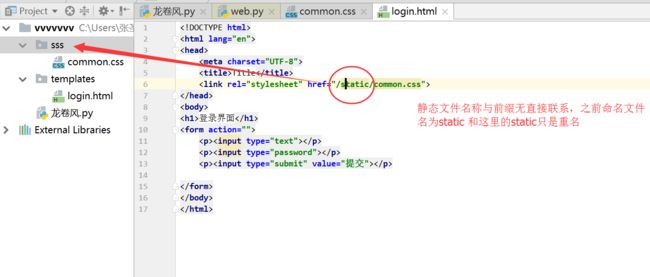official site:
http://www.tornadoweb.org/en/stable/
Tornado is a Python web framework and asynchronous networking library, originally developed at FriendFeed. By using non-blocking network I/O, Tornado can scale to tens of thousands of open connections, making it ideal for long polling, WebSockets, and other applications that require a long-lived connection to each user.
总结:在非阻塞I/O下实现高并发。
安装
pip install tornado
源码安装
https://pypi.python.org/packages/source/t/tornado/tornado-4.3.tar.gz
一、QuickStart
#!/usr/bin/env python
# -*- coding:utf-8 -*-
import tornado.ioloop
import tornado.web
class MainHandler(tornado.web.RequestHandler):
def get(self):
self.write("Hello, world")
application = tornado.web.Application([
(r"/index", MainHandler),
])
if __name__ == "__main__":
application.listen(8888)
tornado.ioloop.IOLoop.instance().start()
第一步:执行脚本,监听 8888 端口
第二步:浏览器客户端访问 /index --> http://127.0.0.1:8888/index
第三步:服务器接受请求,并交由对应的类处理该请求
第四步:类接受到请求之后,根据请求方式(post / get / delete ...)的不同调用并执行相应的方法
第五步:方法返回值的字符串内容发送浏览器
异步非阻塞实例
#!/usr/bin/env python
# -*- coding:utf-8 -*-
#!/usr/bin/env python
# -*- coding:utf-8 -*-
import tornado.ioloop
import tornado.web
from tornado import httpclient
from tornado.web import asynchronous
from tornado import gen
import uimodules as md
import uimethods as mt
class MainHandler(tornado.web.RequestHandler):
@asynchronous
@gen.coroutine
def get(self):
print 'start get '
http = httpclient.AsyncHTTPClient()
http.fetch("http://127.0.0.1:8008/post/", self.callback)
self.write('end')
def callback(self, response):
print response.body
settings = {
'template_path': 'template',
'static_path': 'static',
'static_url_prefix': '/static/',
'ui_methods': mt,
'ui_modules': md,
}
application = tornado.web.Application([
(r"/index", MainHandler),
], **settings)
if __name__ == "__main__":
application.listen(8009)
tornado.ioloop.IOLoop.instance().start()
异步非阻塞实例
二、URLConf
路由系统其实就是 url 和 类 的对应关系,这里不同于其他框架,其他很多框架均是 url 对应 函数,Tornado中每个url对应的是一个类。
import tornado.ioloop
import tornado.web
class MainHandler(tornado.web.RequestHandler):
def get(self):
self.write("Hello, world")
class StoryHandler(tornado.web.RequestHandler):
def get(self, story_id):
self.write("You requested the story " + story_id)
class BuyHandler(tornado.web.RequestHandler):
def get(self):
self.write("buy.wupeiqi.com/index")
application = tornado.web.Application([
(r"/index", MainHandler),
(r"/story/([0-9]+)", StoryHandler),
])
application.add_handlers('buy.wupeiqi.com$', [
(r'/index',BuyHandler),
])
if __name__ == "__main__":
application.listen(80)
tornado.ioloop.IOLoop.instance().start()
三、templates
Tornao中的模板语言和django中类似,模板引擎将模板文件载入内存,然后将数据嵌入其中,最终获取到一个完整的字符串,再将字符串返回给请求者。
Tornado 的模板支持“控制语句”和“表达语句”,控制语句是使用 {% 和 %} 包起来的 例如 {% if len(items) > 2 %}。表达语句是使用 {{ 和 }} 包起来的,例如 {{ items[0] }}。
控制语句和对应的 Python 语句的格式基本完全相同。我们支持 if、for、while 和 try,这些语句逻辑结束的位置需要用 {% end %} 做标记。还通过 extends 和 block 语句实现了模板继承。这些在 template 模块 的代码文档中有着详细的描述。
layout.html
老男孩
{% block CSS %}{% end %}
{% block RenderBody %}{% end %}
{% block JavaScript %}{% end %}
layout.html
index.html
{% extends 'layout.html'%}
{% block CSS %}
{% end %}
{% block RenderBody %}
Index
{% for item in li %}
- {{item}}
{% end %}
{% end %}
{% block JavaScript %}
{% end %}
index.html
import tornado.ioloop
import tornado.web
class MainHandler(tornado.web.RequestHandler):
def get(self):
self.render('home/index.html')
settings = {
'template_path': 'template',
}
application = tornado.web.Application([
(r"/index", MainHandler),
], **settings)
if __name__ == "__main__":
application.listen(80)
tornado.ioloop.IOLoop.instance().start()
在模板中默认提供了一些函数、字段、类以供模板使用:
escape: tornado.escape.xhtml_escape 的別名
xhtml_escape: tornado.escape.xhtml_escape 的別名
url_escape: tornado.escape.url_escape 的別名
json_encode: tornado.escape.json_encode 的別名
squeeze: tornado.escape.squeeze 的別名
linkify: tornado.escape.linkify 的別名
datetime: Python 的 datetime 模组
handler: 当前的 RequestHandler 对象
request: handler.request 的別名
current_user: handler.current_user 的別名
locale: handler.locale 的別名
_: handler.locale.translate 的別名
static_url: for handler.static_url 的別名
xsrf_form_html: handler.xsrf_form_html 的別名
静态文件配置注意(和Django类似):
csrf
Tornado中的夸张请求伪造和Django中的相似,跨站伪造请求(Cross-site request forgery)
配置
settings = {
"xsrf_cookies": True,
}
application = tornado.web.Application([
(r"/", MainHandler),
(r"/login", LoginHandler),
], **settings)
html



